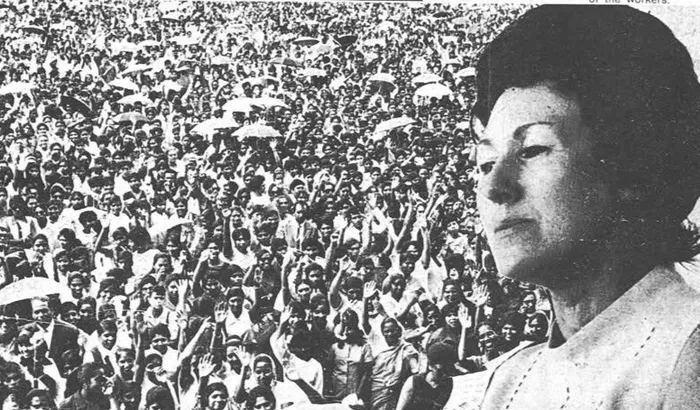The kindness of Harriet Bolton and clothing factory workers
A better life

Mrs Harriet Bolton worked tirelessly for the rights of workers in ensuring that they were appropriately paid and were able to receive worker benefits that developed into tertiary education bursaries.
Image: Supplied
MY WIFE'S matric results secured her a welcome bursary from the Garment Worker’s Industrial Union (GWIU) that paid for her studies at the University of Durban-Westville. We are eternally grateful for that bursary that would completely alter the trajectory of my wife’s future.
In this journey of our life, a set of fortunate events, together with the hard work of clothing factory workers conspired to give us a better life that is a priceless gift to our children and their future.
In that time of my mother-in-law working at the textile factory many women were able break that cycle of poverty that trapped our indentured ancestry for more than 100 years. In 100 years from 1860 to 1960, life’s journey for the majority of South African Indians was a wretched existence. In a journal article, The 'Culture of Poverty' and the South African poor by Geoffrey H Waters in 1978, it was estimated that 64% of Indians living in South Africa, lived below the poverty datum line.
Hopes to break that endless cycle of poverty was often dashed, as conditions to accelerate advancement was not conducive. Limited employment opportunities, apartheid era job reservation, successive world wars, colonial and apartheid era depredations together with depressed economies, all contrived to keep advancement at bay. The apartheid state expropriated prime urban land that ripped the heart away from people who lived in the Magazine & Railway Barracks, Mayville, Cato Manor, Block AK Greyville, etc. These people were forcibly removed to places like Chatsworth and Phoenix, 20 to 30 kilometres from their places of work.
To account for the high cost of living, ladies in the new townships were now forced to work to make life bearable. The number of Indian women working in factories, especially in the garment industry, grew dramatically during the 1960s. While in 1951 only 1518 Indian women were employed in industry, by 1970 this grew to 13 530. Their wages were vital to survival in the new townships, where the demands of rent, electricity and the vast amount of modern consumer goods put pressure on the family’s income.
Crowds of women waited at bus stops leaving early in the morning and arriving late in the evening, still coming home to cook a family meal. They worked tirelessly in providing life’s little luxuries like that Friday treat of queen cake that we couldn’t wait to wolf down.
The bursary that my wife secured was mainly due to the tenacity of a leading light for rights of textile factory workers found in the name of Harriet Bolton. She was married to Jimmy ‘JC’ Bolton who formed the Garment Worker’s Industrial Union in 1934. By the time Mrs Bolton became General Secretary for the GWIU, Indian women started to enter the industry in significant numbers from 1960, while the number of Indian men employed in clothing factories, until then in the majority, started to decline.
In 1965, membership of the GWIU was made up of 6 648 male workers and 6 715 female workers. By 1967 this had grown to 7582 female workers, while the number of males dropped to 6 420. Indian workers made up just over 79% of workers in the industry.
Over the next three years, Harriet and the executive of GWIU attempted to install more democracy into union structures and improve contact with workers. The GWIU under the stewardship of Mrs Bolton worked tirelessly for the rights of workers in ensuring that they were appropriately paid and were able to receive worker benefits that developed into tertiary education bursaries that my wife became a recipient of. In the year of the Durban Strikes of 1973, Harriet Bolton was persecuted for her role on mobilising the masses in the fight for worker rights.
Many others too have played a significant role in fighting for the rights of textile factory workers. Garment workers union activists Margaret Rajbally, Pregs Govender, Emma Mashinini and many others have contributed immensely to the plight of workers in an industry whose voices were not often heard.
The lowering of trade barriers at the advent of democracy marked the start of the steep decline, if not the death, of industries such as the clothing, textile and footwear sectors that our parents had so tirelessly worked in. The chilly wind of globalization showed its fierce teeth that now see us buying clothing almost exclusively from foreign countries.
The author Selvan Naidoo, together Kiru Naidoo and Advocate Zandile Qono-Reddy, are part of the Sites of Conscience Collective recording history and heritage related to the freedom struggle.
** The views expressed do not necessarily reflect the views of IOL or Independent Media.